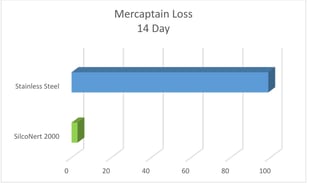
Sometimes your nose knows better. When you were in the field you were sure you smelled the gas odorant, but now when the sample hits the GC SCD detector, nothing... Did I really smell the mercaptan? Was it just my imagination; or is the sample transfer system stealing reactive odorants? If you're wondering if the sample cylinder, transfer tubing fittings or GC components are potentially adsorbing mercaptan, you're right. A study by OLFASCAN nv* recently compared various sample pathways for odorant inertness. The study compared stainless steel to PTFE and SilcoNert® 2000 (Siltek®) coating.

The study concludes:
- Uncoated stainless steel promotes formation of disulfides and is adsorptive.
- Use SilcoNert® coated stainless steel, PTFE, or deactivated SS to prevent adsorption.
- Using inert coatings allow detection limit to approach mercaptan odor threshold.
Ultra inert SilcoNert® prevents adsorption of mercaptans, assuring sample stability for up to 14 days.

Coat the entire sample flowpath.
One uncoated fitting or sintered metal frit can adsorb odorants; resulting in distortion of results or complete loss of sample.
Coat:
- Fittings
- Valves
- Regulators
- Transfer tubing
- Filters
- Injectors
- Liners
- Sample cylinders
- Heat trace tubing
|
 |
It's easy to assure a reliable odorant sampling system. You can buy coated sampling components from some of the world's best manufacturers and suppliers of sampling and GC systems.

*Kurt Haerens, OLFASCAN nv, "Sampling and analysis of mercaptans", Emissions and Odours from Materials 2015





